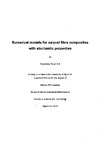Numerical models for natural fibre composites with stochastic properties
| dc.contributor.supervisor | Summerscales, John | |
| dc.contributor.author | Virk, Amandeep Singh | |
| dc.contributor.other | Faculty of Science and Engineering | en_US |
| dc.date.accessioned | 2011-06-28T15:22:24Z | |
| dc.date.available | 2011-06-28T15:22:24Z | |
| dc.date.issued | 2010 | |
| dc.date.issued | 2010 | |
| dc.identifier | 356692 | |
| dc.identifier | Not available | en_US |
| dc.identifier.uri | http://hdl.handle.net/10026.1/517 | |
| dc.description | Merged with duplicate record (10026.1/303) on 03.01.2017 by CS (TIS) | |
| dc.description | This is a digitised version of a thesis that was deposited in the University Library. If you are the author please contact PEARL Admin (pearladmin@plymouth.ac.uk) to discuss options. | |
| dc.description.abstract |
Natural fibres are increasingly being considered as the reinforcement for polymer matrix composites as they are perceived to be sustainable being a renewable resource. However, they suffer from higher variability in mechanical properties and concerns about their long-term durability in a moist environment. In this study the physical properties of the jute fibres were characterised, the fibre length distribution was determined and the fibre cross-section was analysed using digital images. It was observed that the true fibre area followed a log-normal distribution. The fibre area distribution for different geometrical shapes was estimated and the error in the estimated area of assumed fibre cross-section was also determined to assess the applicability of the assumed cross-section. The mechanical properties of the jute technical fibres from a single batch from South Asia were determined; fibre tensile tests were carried out at ten different gauge lengths between 6 mm and 300 mm and the Young’s modulus, strain to failure and ultimate tensile strengths were determined individually. A strong correlation was observed between the fibre strength/fracture strain and fibre gauge length. It was found as the gauge length increases the fibre strength/fracture strain drops. The fibre failure (Strength/Strain) was modelled using Weibull distribution and three statistical models were developed to relate the fibre strength/fracture strain to the fibre gauge length. Examination of tensile test data reveals that the coefficient of variation (CoV) for failure strain is consistently lower than the CoV for fracture stress (strength), as the failure strain is weakly influenced by the fibre cross-section. Hence, failure strain is the more consistent failure criterion and it is recommended to use failure strain as the key design criterion for natural fibre composites in order to improve reliability in the design of these materials. Different authors have tried to model natural fibre reinforced polymer elastic modulus using micromechanical models and have suggested that further study should include fibre angle and length distribution factors to improve the micromechanical prediction. This thesis further seeks to validate a novel methodology for the prediction of the tensile modulus and strength of natural fibre composites through careful consideration of each of the parameters in the rule of mixtures along with consideration of the statistical variation inherent in reinforcements extracted from plants. The tensile modulus and strength of jute fibre reinforced composites manufactured from well characterised fibres was measured experimentally. Six well established micromechanical models were used to predict the composite elastic modulus. Two micromechanical models were used to predict composite strength. For both mechanical properties, the inclusion of a fibre area correction factor to account for the non-circular cross-section of the fibre resulted in an improved prediction of the respective mechanical properties. | |
| dc.language.iso | en | en_US |
| dc.publisher | University of Plymouth | en_US |
| dc.subject | Composite | |
| dc.subject | Natural fibres | |
| dc.subject | Weibull | |
| dc.subject | Statistics | |
| dc.subject | Digital image processing | |
| dc.title | Numerical models for natural fibre composites with stochastic properties | en_US |
| dc.type | Thesis | en_US |
| dc.identifier.doi | http://dx.doi.org/10.24382/1371 |
Files in this item
This item appears in the following Collection(s)
-
01 Research Theses Main Collection
Research Theses Main


